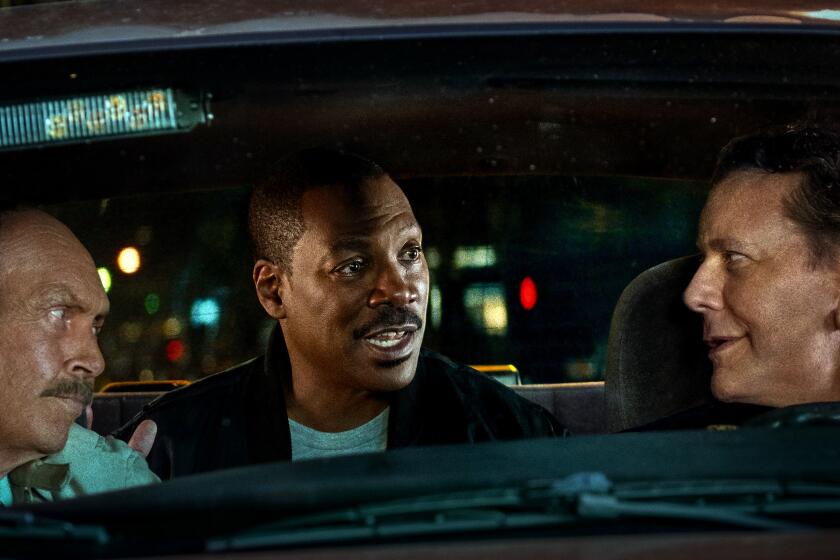For classic Hollywood films, this is the best and worst of times
For those of us with an abiding interest in old films, in what’s come to be called “Classic Hollywood,” we’re living through wonderful times and terrible times. It all depends on where you look.
I’m not just talking about changes in the physical medium itself, about the abrupt end of 35-mm projection and the switch to digital in all but specialized locations like the American Cinematheque’s Egyptian Theater, recently retrofitted to show rare and fragile 35-mm nitrate prints. The pros and cons of that fraught question would take a book in itself to parse.
Rather, I’m talking about the waves classic cinema makes in the broader film culture, about the current films that connect with it and the new books and monographs that continue to plumb its secret, almost bottomless depths, offering encouragement to the faithful and also some things to worry about.
Continually on my mind in that context since I saw it at the Venice Film Festival last month is Bill Morrison’s wondrous, almost indescribable documentary “Dawson City: Frozen Time.” Morrison is best known for “Decasia: The State of Decay,” in which he found so much beauty in old and decaying nitrate footage that his 2002 effort was the first 21st century film to be selected for the prestigious National Film Registry.
With “Dawson City,” Morrison has taken his sensibility one step further. Part compelling history, part remarkable aesthetic experience, it focuses on the celebrated 1978 discovery of about 500 lost silent features and newsreels from the 1910s and ’20s, including the only known footage of the notorious Chicago Black Sox, all buried for half a century in an abandoned swimming pool behind Diamond Tooth Gertie’s gambling hall in the gold rush boomtown that was the Yukon Territory’s Dawson City.
Morrison tells several stories here, intertwining the chronology of Dawson City and the larger-than-life characters who passed through it with the history of these films, how they arrived, were lost and then rediscovered, and illustrating it all with clips from the motion pictures themselves. It’s a complete astonishment from beginning to end, aptly described by the director himself as “both a cinema of mythology and a mythologizing of cinema.”
Equally entrancing are a trio of newly published coffee-table books that delve with remarkable specificity and dexterity into different areas of the classic film universe.
The most specific, and a book whose fanatical inclusiveness is truly impressive, is “King of Jazz: Paul Whiteman’s Technicolor Revue,” a work of scholarship and obsession by James Layton and David Pierce published by Media History Press.
Released in 1930, “King of Jazz” was one of the earliest and most ambitious of sound musicals, a fine example of a vivid visual system called two-color Technicolor, and remains what entertainer Michael Feinstein calls “an authentic time capsule” of the taste and sensibility of the period. Among other things, “King of Jazz” marked the first on-screen appearance of Bing Crosby and an elaborate production of George Gershwin’s “Rhapsody In Blue” (Universal paid a then-astronomical $50,000 for the rights) featuring a giant 40-foot piano with keys 5 feet long and 1 foot wide.
Despite its elaborate scale, “King of Jazz” did not perform well in its initial release and was so cut and re-cut that Benito Mussolini, of all people, was said to be one of the few who owned a complete print. Universal recently completed a frame-by-frame digital restoration, and this richly illustrated volume not only describes that in detail, it tells you everything you would ever want to know about the initial production and subsequent releases and everyone involved with them.
Equally site-specific and impressively comprehensive is “The Walt Disney Film Archives: The Animated Movies, 1921-1968,” a massive 620-page doorstop of a book that covers the movies Walt himself had a hand in, from his early Kansas City shorts to “The Jungle Book.” Published by Taschen and slated to be one of five volumes that samples the 6.5-million-item Walt Disney Archives, this book is a trove of striking imagery, including story sketches, background paintings and production cells.
And the words are not half bad either, including essays by Disney experts like Leonard Maltin, Russell Merritt and Charles Solomon and excerpts from Disney’s legendary story conferences, like Walt saying apropos of “Fantasia,” “I was always known as the perfectionist until I met Stokowski.”
The most wide-ranging of books covering the entire studio system is the gorgeous “The Art of the Hollywood Backdrop” by Richard M. Isackes and Karen L. Maness and published by Regan Arts.
The use of large-scale backdrops carefully painted on huge canvases of heavyweight cotton muslin was once something of a movie business secret, “one of the great and beautiful mysteries of film creation” in the words of Oscar-winning production designer Dean Tavoularis.
To turn the pages of this book is to feel like you’ve entered a legendary treasure house filled with magnificent images, paintings that fooled the eye in such films as “The Wizard of Oz” and “North by Northwest.”
Often as anonymous as the medieval craftsmen who built the great cathedrals, these artists are given their due here for work so impeccable that Catholic priests at a screening of “The Shoes of the Fisherman” were overheard scandalized that filming had been allowed in the Sistine Chapel when in fact a painted backdrop had been employed.
If these books have anything in common, it is that they wouldn’t exist without earlier generations of collectors, people who felt that it was important to save both artifacts and, in the case of “The King of Jazz,” prints of the film itself that more short-sighted individuals felt were disposable. Which is where yet another new book, “A Thousand Cuts,” comes in.
Written by Dennis Bartok of the American Cinematheque and Jeff Joseph and published by the University Press of Mississippi, this charming, anecdote-rich narrative conveys its alternately heartening and depressing message in its subtitle: “The Bizarre Underground World of Collectors and Dealers Who Saved the Movies.”
Bartok and Joseph, himself a former collector and dealer whose passion for cinema led to a federal prison sentence for copyright infringement (a story in itself, which the book tells), introduce us to the raffish world of cinephiles and movie wheeler dealers who want to own real, physical films no matter what the cost.
People like Emil Varga, who asked to be buried with a reel of film. Or Hillary Hess, who bought a house because it had enough room for her 35-mm projectors. Or Mike Hyatt, who spent more than 30 years seeking to preserve and restore the best possible version of a science fiction gem called “The Day of the Triffids.”
In addition to telling great stories, “A Thousand Cuts” wants to make two points. One is that each collector profiled has saved something of value that might otherwise have been discarded, and that without world-class accumulators like Henri Langlois, founder of the Cinematheque Francaise, and the controversial Raymond Rohauer, much material we take for granted would have been gone.
The second point is considerably more discouraging. Not only are these collectors aging and dying out — in fact, eight of the people “A Thousand Cuts” deals with have passed on since being interviewed — but a new generation of younger collectors passionate about rescuing the past from oblivion is not rising up to take their place. So let’s pause a moment to be thankful for the unblinking obsessives who took cinemania to irrational heights. We owe them an enormous debt that looks bigger every day.
More to Read
Only good movies
Get the Indie Focus newsletter, Mark Olsen's weekly guide to the world of cinema.
You may occasionally receive promotional content from the Los Angeles Times.






